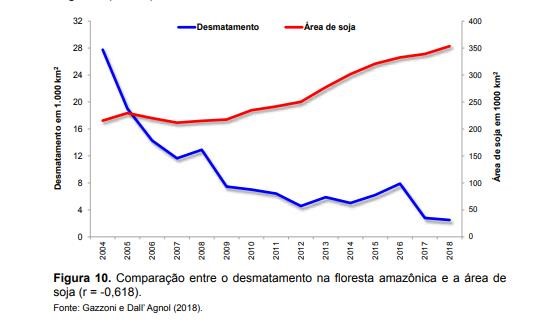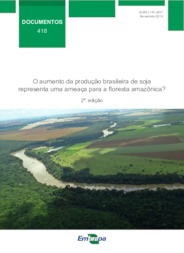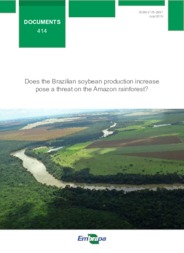Brazilian soybean has technology to increase production without pressure for forest areas
Brazilian soybean has technology to increase production without pressure for forest areas
The development of its own technologies allows Brazil, a world leader in soybean production, to sustainably produce the grain without putting pressure on forest areas, even considering the scenarios of increased demand for the grain in the coming years. The analysis presented in 2019 by researchers from the Brazilian Agricultural Research Corporation (Embrapa) remains valid and answers part of the international questions about the Brazilian production system. With the title "Does the increase in Brazilian soybean production pose a threat to the Amazon rainforest?", the study analyses whether the prospects for increasing global demand could cause greater pressure on the Amazon rainforest, as has been suggested in the international environment.
A leader in world soybean production, Brazil produced 125 million tons of the oilseed grain in the 2019/20 season. Soybean occupies approximately 37 million hectares and the increase in global demand and thus in soybean production is a challenge for Brazil, which will require engagement of the entire production chain. “Embrapa and partners have a broad agenda of technologies and research that guarantees the sustainable growth of the Brazilian soybean production, the main source of protein for the world”, highlights Alexandre Nepomuceno, general head of Embrapa Soybean.
“The application of high technology and sustainable practices in Brazilian agriculture like no-till farming has allowed production increase per unit area, while simultaneously preserving water, nutrients, and carbon sequestration in the soil. The recovery of areas like degraded pastures has also allowed an increase in production. There is still a lot of space for Brazil to continue helping to feed the planet without putting pressure on environmental preservation areas. The preservation of native forests is also strategic for Brazilian agribusiness in social, economic and environmental aspects ”, explains Nepomuceno.
According to Décio Gazzoni, a researcher at Embrapa Soybean, and one of the authors of the study, Brazil has systematically designed several international scenarios of demand in the soybean market for the next decades and developed strategies to achieve these scenarios in a sustainable manner. “Soybean cultivation in the Amazon biome is absolutely out of any scenario of expansion in the soybean volume produced in the country not only due to environmental issues and legal restrictions, but also due to economic, logistical, technical and financial issues”, points out Gazzoni.
In addition to preserving the forest as a national heritage, Brazil has the technological mastery to double current production in areas that are already cultivating soybeans or recovering degraded pasture areas. “The increases in Brazilian production in recent years are directly associated with new crop management recommendations, the genetic potential of cultivars and the new perspectives opened up by combining degraded pasture areas in more efficient systems through Integrated Crop-Livestock-Forestry Systems (ICLFS) ”, he explains. “The growth in production volume is much more based on increased productivity than on the increase in planted area”, he highlights.
The study conducted by Embrapa researchers also compared data on deforestation in the Amazon region and the expansion of the area used for soybean production in the period from 2005 to 2018. According to the study's authors, in addition to the country having one of the most stringent environmental laws in the world, the private sector itself has established strict commitments to preserve the Amazon biome. “The exploitation of these areas for soybean is neither environmentally nor economically adequate”, explains Gazzoni.

Figure 10. Comparison between deforestation in the Amazon rainforest and the soybean area (r = -0,618) Source: Gazzoni and Dall 'Agnol (2018)
Desmatamento = Deforestation
Área de soja = Soybean production area
Desmatamento em 1.000 km² = Deforestation in 1,000 km²
Área de soja em 1.000 km² = Soybean production area in 1,000 km²
The study also provides examples of how Brazil increased its agricultural production in the last decades. Such examples responsible for the sustainable growth of production include the technologies that allowed pasture improvement by inserting agriculture in soil recovery, including ICLFS, estimated at 11.5 M ha in 2016. Another innovation in tropical agriculture was the agricultural intensification process, that is, the use of two, sometimes three, cultivation cycles per year, in the same area, which entails reducing the area needed for the same agricultural production.
The researcher Marco Nogueira, another author of the study, points out that the Brazilian production system is anchored in technologies that are environmentally friendly. “Among them are biological nitrogen fixation (which dispenses with nitrogen fertilizer and therefore reduces greenhouse gas emissions and the contamination of groundwater with nitrates), no-till farming (which conserves the soil, retains water and fixes carbon), integrated pest and disease management techniques, which form a set of technologies that reduce carbon emissions into the atmosphere,” he exemplifies.
The full study is available on: https://www.embrapa.br/soja/busca-de-publicacoes/-/publicacao/1111175/does-the-brazilian-soybean-production-increase-pose-a-threat-on-the-amazon-rainforest
Carina Rufino and Lebna Landgraf
Lebna Landgraf (Mtb 2309 -PR)
Embrapa Soybean
Press inquiries
soja.imprensa@embrapa.br
Phone number: +55 43-3371-6061
Mariana Medeiros (Editing - English)
General Secretariat
Further information on the topic
Citizen Attention Service (SAC)
www.embrapa.br/contact-us/sac/



